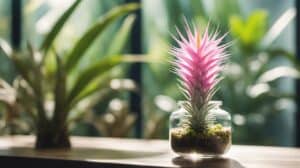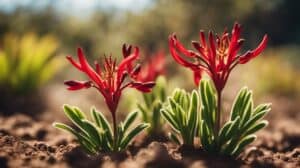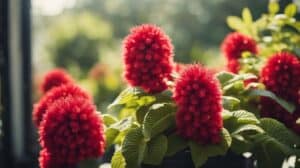Dinosaur Plant, also known as Elephant’s Foot (Dioscorea elephantipes), is a unique plant that has captured the attention of many plant enthusiasts. This plant is native to South Africa and is known for its unusual appearance, resembling a miniature dinosaur egg. The plant has a bulbous base that can grow up to 1 meter in diameter, and it produces long, slender stems that can reach up to 3 meters in length.

One of the most fascinating aspects of the Dinosaur Plant is its ability to propagate itself. The plant produces small, round, black seeds that are dispersed by the wind. However, the plant can also reproduce asexually by producing new bulbs from its base. This means that a single plant can create a cluster of bulbs, creating a unique and impressive display. In this article, we will explore the process of propagating Elephant’s Foot, so you too can enjoy this remarkable plant in your own home or garden.
Understanding Elephant’s Foot
Botanical Profile
Dioscorea elephantipes, also known as Elephant’s Foot, is a unique plant species that belongs to the family of Dioscoreaceae. It is native to South Africa and is known for its tuberous stem that resembles an elephant’s foot. The stem can grow up to 30 cm in diameter and has a rough, scaly texture. The plant also produces long, slender vines that can grow up to 5 meters in length.
The leaves of Elephant’s Foot are heart-shaped and can grow up to 20 cm in length. They are usually green in color and have a glossy texture. The plant produces small, inconspicuous flowers that are greenish-yellow in color.
Growth Characteristics
Elephant’s Foot is a slow-growing plant that prefers well-draining soil and moderate sunlight. It is a drought-tolerant plant and can survive long periods of dry weather. The plant is also adapted to fire-prone environments and can resprout after a fire.
Propagation of Elephant’s Foot is usually done through the tuberous stem. The stem can be cut into sections and planted in well-draining soil. The plant can also be propagated through seeds, but this method is less common.
Overall, Elephant’s Foot is a fascinating plant species that is well-suited for arid environments. Its unique appearance and growth characteristics make it a popular choice for collectors and enthusiasts.
Propagation Basics

Best Time to Propagate
The best time to propagate the Dinosaur Plant is in the spring season, when the plant begins to grow new shoots. During this time, the plant is actively growing and will be better able to handle the stress of being propagated.
Required Materials
To propagate the Dinosaur Plant, you will need the following materials:
- A healthy adult plant
- A sharp knife or pruning shears
- A suitable pot or container
- Well-draining soil mix
- Water
Before propagating, ensure that the adult plant is healthy and free of any diseases or pests. It is also important to select a pot or container that is large enough to accommodate the new plant and has good drainage.
Once you have gathered the required materials, you can proceed with the propagation process.
Propagation Techniques

Dinosaur plants can be propagated through three different techniques: seed propagation, cuttings propagation, and offsets propagation.
Seed Propagation
Propagation through seeds is the most common method for dinosaur plants. The seeds should be sown in spring or early summer in well-draining soil. The seeds should be placed 1 inch deep in the soil and watered regularly. Germination can take up to 3 months, and it is important to keep the soil moist during this time. Once the seedlings are big enough to handle, they can be transplanted into individual pots.
Cuttings Propagation
Propagation through cuttings is a more challenging technique, but it can be successful with proper care. Cuttings should be taken in spring or early summer from the base of the plant. The cuttings should be allowed to dry for a few days before being planted in well-draining soil. It is important to keep the soil moist during this time. Once the cuttings have rooted, they can be transplanted into individual pots.
Offsets Propagation
Propagation through offsets is the easiest and most reliable technique. Offsets are small bulbils that grow at the base of the plant. They can be removed and planted in well-draining soil. It is important to keep the soil moist during this time. Once the offsets have rooted, they can be transplanted into individual pots.
Overall, dinosaur plants are easy to propagate, and each technique has its advantages. Seed propagation is the most common method, cuttings propagation is more challenging but can be successful, and offsets propagation is the easiest and most reliable technique.
Aftercare and Tips

Post-Propagation Care
After the successful propagation of the dinosaur plant, it is important to take proper care of it to ensure its healthy growth. The following tips can help in the post-propagation care of the elephant’s foot:
- Watering: The plant requires moderate watering. Overwatering can lead to root rot and other fungal diseases. Water the plant only when the soil is dry to the touch.
- Lighting: The plant prefers bright, indirect sunlight. Direct sunlight can scorch the leaves and cause damage to the plant.
- Temperature: The ideal temperature for the plant is between 60-80°F (15-27°C). Avoid exposing the plant to extreme temperatures.
- Fertilizing: Fertilize the plant once a month with a balanced fertilizer. Avoid over-fertilizing as it can lead to the accumulation of salts in the soil.
Common Challenges
While the elephant’s foot is a hardy plant, it can face some challenges during its growth. Some of the common challenges and their solutions are:
- Pests: The plant can be affected by spider mites, mealybugs, and other pests. Regularly inspect the plant for any signs of infestation and treat it promptly with an appropriate insecticide.
- Yellowing Leaves: Yellowing leaves can be a sign of overwatering or underwatering. Adjust the watering schedule accordingly.
- Root Rot: Overwatering can lead to root rot, which can be fatal for the plant. If the plant shows signs of root rot, remove the affected roots and repot the plant in fresh soil.
By following these post-propagation care tips and addressing any challenges that arise promptly, the elephant’s foot can thrive and add a unique touch to any plant collection.
Frequently Asked Questions

What is the best method for propagating Elephant’s Foot from cuttings?
The best method for propagating Elephant’s Foot is by using offsets. These are small bulbs that grow at the base of the parent plant. Once they have reached a decent size, they can be removed and planted in their own pot. Cuttings are not recommended as they do not root easily.
Can you grow Elephant’s Foot plants indoors, and what care do they require?
Yes, you can grow Elephant’s Foot plants indoors. They prefer bright but indirect light and a warm, humid environment. The soil should be kept moist but not waterlogged, and they should be fertilized every few months with a balanced fertilizer.
What type of soil is ideal for cultivating Dioscorea elephantipes?
Elephant’s Foot plants prefer well-draining soil that is rich in organic matter. A mixture of peat moss, sand, and perlite is ideal. The pH should be slightly acidic, around 6.0-6.5.
Where can I purchase a Dioscorea elephantipes plant?
Elephant’s Foot plants can be purchased online from various nurseries and plant shops. It is important to ensure that the seller is reputable and that the plant is healthy before making a purchase.
What is the average price range for an Elephant’s Foot plant?
The price range for an Elephant’s Foot plant can vary depending on the size and age of the plant. They can range from $20 to $100 or more.
How often should you water an Elephant’s Foot plant?
Elephant’s Foot plants should be watered when the soil feels dry to the touch. This can range from once a week to once every few weeks depending on the environment and the size of the plant. Overwatering can lead to root rot, so it is important to not let the soil become waterlogged.












